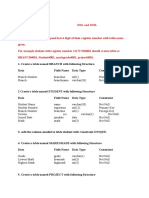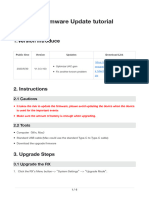0% found this document useful (0 votes)
17 views24 pagesLab 2 - Basic DDL and DML in MySQL
This document provides an overview of MySQL Workbench, focusing on Data Definition Language (DDL) and Data Manipulation Language (DML) commands for database management. It includes instructions for creating databases and tables, inserting and retrieving data, and performing updates and deletions, along with examples. Additionally, it outlines lab tasks related to creating and managing a Boxing_Events table and emphasizes the importance of practicing SQL queries regularly.
Uploaded by
Chirag PatilCopyright
© © All Rights Reserved
We take content rights seriously. If you suspect this is your content, claim it here.
Available Formats
Download as PDF, TXT or read online on Scribd
0% found this document useful (0 votes)
17 views24 pagesLab 2 - Basic DDL and DML in MySQL
This document provides an overview of MySQL Workbench, focusing on Data Definition Language (DDL) and Data Manipulation Language (DML) commands for database management. It includes instructions for creating databases and tables, inserting and retrieving data, and performing updates and deletions, along with examples. Additionally, it outlines lab tasks related to creating and managing a Boxing_Events table and emphasizes the importance of practicing SQL queries regularly.
Uploaded by
Chirag PatilCopyright
© © All Rights Reserved
We take content rights seriously. If you suspect this is your content, claim it here.
Available Formats
Download as PDF, TXT or read online on Scribd
/ 24



























































































